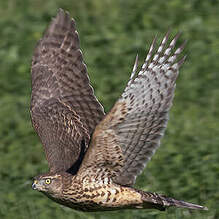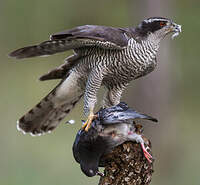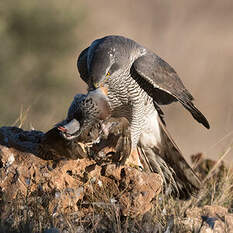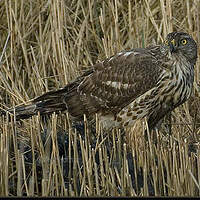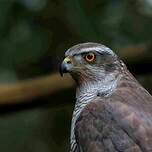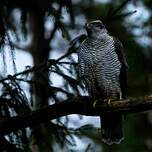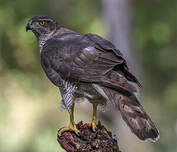Eurasian Goshawk
Astur gentilis - Autour des palombes
Identification
The Northern Goshawk is a large Accipiter, the largest in the northern hemisphere. It is a robust bird built for bird hunting. Let's recall the accipiter characteristics: wide and round wings at the extremity, long to very long tails; when perched, the tips of the wings are at most mid-tail. The goshawk has a long arm allowing for speed peaks in open environment. Adults are identical in plumage, but as it is almost always the case in raptors, the female is much larger than the male. In spite of this, the male is still much larger than a female sparrowhawk. The upper parts of the nominal subspecies gentilis of Western Europe which interests us here are of a rather dark brown-gray, the male more gray than the female. The tail is very clearly barred with brown. The lower parts appear mastic from a distance. This effect comes from the optical mix of thin blackish bars on a white background. The head shows a clear and fine pale eyebrow between the helmet and the blackish cheeks. The lores are pale and the white throat is finely speckled. The iris is bright orange in the male, yellow in the female. The beak is robust. The four strong fingers with long and sharp claws are very powerful to the point that leather gloves are essential when handling a goshawk. How to distinguish goshawk and sparrowhawk in flight ? This is not easy when it is impossible to appreciate the size of the bird. The silhouette is slightly different. In the goshawk, the body is ample with a strong chest, the tail is slightly shorter in proportion and rounder at the tip. The wings, ample, show secondaries with more or less faded bars, almost absent when it's more and especially side body when it's less. This is well appreciated on photos.Ten subspecies are described which differ in the tone of plumage and the intensity of the barring on the underparts. The subspecies arrigonii from Corsica and Sardinia is slightly smaller and darker. The juvenile has a very different plumage. The upperparts are brown, with rust edgings to the feathers, particularly on the wing coverts. The underparts (body and coverts) are very rusty. Numerous dark brown streaking cover the breast. On the flanks, axillaries, and underwing coverts, dark brown spots are visible instead. The barring on the secondaries is fine but not yet blurred. The head shows a distinct creamy eyebrow against a brown background. The iris is pale yellow. The cere is lemon yellow.
Subspecific information 7 subspecies
- Astur gentilis gentilis (c and n Europe)
- Astur gentilis buteoides (n Eurasia)
- Astur gentilis albidus (ne Siberia)
- Astur gentilis schvedowi (ne Asia to c China)
- Astur gentilis fujiyamae (Japan)
- Astur gentilis arrigonii (Corsica, Sardinia)
- Astur gentilis marginatus (Italy and the Balkans to Caucasus and n Iran)
Foreign names
- Autour des palombes,
- Azor común,
- açor-nortenho,
- Habicht,
- héja,
- Havik,
- Astore,
- duvhök,
- Hønsehauk,
- jastrab veľký,
- jestřáb lesní,
- Duehøg,
- kanahaukka,
- astor comú,
- Gáshaukur,
- jastrząb (zwyczajny),
- vistu vanags,
- kragulj,
- Тетеревятник,
- オオタカ,
- 苍鹰,
- เหยี่ยวนกเขาท้องขาว,
- 蒼鷹,
Voice song and call
The Northern Goshawk is a silent bird for most of the year. It is during the breeding season that it becomes vocal in its territory. The most common call, the one for example which is heard when entering its territory, is a long and powerful kiak kiak kiak kiak kiak... sound which carries far in the forest. It is an adult's alarm call and the males have a more powerful call than the females. They also emit wouuiiiah sounds with a higher tone than the buzzard's call. It is these two calls that must be known, for example for inventories. Other calls are also given by adults in privacy. The juveniles at the nest are demanding with wouuiiih insistent trills.
Habitat
The Northern Goshawk is a forest-dwelling species which nests and hunts in forests, but can also hunt outside of forests.
Behaviour character trait
In March, aerobatic displays usually come before mating season. People can easily spot them once they know the nesting site.
It is better to be a bit far away yet in an ideal spot to view the canopy. Usually the female rises in a circular motion above the territory. Her flight has a distinctive broad and slow motion. At this point the white subcaudal feathers become visible. The shape is definitely unique. At the same time, her partner is heard calling in the forest. Eventually, the female slows down and dives with closed wings into the canopy at a high speed. It can be very spectacular. When a Northern Goshawk captures a prey in an open area, it quickly seeks the shelter of a bush or hedge to start plucking and eating it, in the absence of human disturbance unfortunately so often present. That is why whole plucked preys can be found in these spots. The same goes for the sparrowhawk but on a smaller scale.Flight
The flight, alternating between flapping and gliding on acquired speed, is typically accipiter. To distinguish it from the sparrowhawk, one must be attentive to size, to the silhouette with long wings, rounded tail and strong chest. The Northern Goshawk is capable of hunting in a dense forest with a rapid flight. Its agility in this closed environment is astonishing. As for the display flight, it has been described above.
Dietfeeding habits
The Northern Goshawk is an opportunistic predator, who adjusts its predation according to the availability of its resources.
It is a robust and fairly large bird of prey, mainly predating on birds but also on medium-sized mammals. In France, its usual prey are gamebirds, particularly woodpigeon but also pallid and crossbill, corvids (crow, Carrion Crow, jackdaw, magpie and jay), Laridae (Caspian Gull for example), large passerines (starling, blackbird and thrushes, Great Tit) but the list is not exhaustive by any means. I have also seen it successfully take on a buzzard. Red squirrels and European rabbits are potential prey. The goshawk often hunts while perching, for example in the forest edge, and captures its prey by surprise, after a short, low and silent flight in open or semi-open habitats. It can also hunt by stooping and taking advantage of the surprise effect of its abrupt appearance. In woodland, it probably first hears its prey and then closes in, waiting for the right moment to attack. It is capable of chasing its prey closely, maneuvering between the trees. The prey is caught with effective talons, pinned to the ground and killed with a strike of the beak. In the open environment, the goshawk looks for the shelter of shrubs and trees to pluck and consume its prey.Reproduction nesting
The breeding season starts early, as early as March, with aerial parades and the reoccupying of the territory by the pair that stayed with each other during the bad season.
An old breeding area is systematically reused if nesting had been successful the previous year. Otherwise, the pair alternates between other nearby territories they possess. The Northern Goshawk's territory is typical. It is always placed high in a tree, against a trunk or in a major fork. It is voluminous if compared with those of raptors of similar size like the buzzard or Black Kites. Its diameter is close to one meter. It is made of dry fine branches, much finer than those of the previously mentioned raptors. At egg laying time, the adults bring green branches. This continues during the incubation period. All of these characteristics make it typical. In the first decade of April, later in higher altitudes and latitudes, the female lays 2 to 4 (1 to 5) dirty white eggs at a rate of one every two days. Incubation starts at the beginning of laid eggs, which will spread their hatchings. It lasts 30 days per egg, mainly assured by the female being supplied by the male. The siblings grow quickly and take flight 36 to 40 days after hatching. They are still fed for some time but, in principle, they are ready to hunt by themselves about one month after flight.Geographic range
The Northern Goshawk has a Holarctic distribution, being present from one side to the other of the Bering Strait continuously across the entire North America and Eurasia in temperate and boreal latitudes. The majority of the populations are resident where they are found. Only birds from the far north migrate southwards. Gene flow is achieved through young birds seeking a new territory. It is only present in the African continent in the Rif Mountains of Morocco. A nucleus of the schvedovi subspecies from Eastern Asia occupies the Himalayan range and mountains of central China. It is only a winter visitor in Korea and SE China.
Threats - protection
IUCN conservation status
concern
in the Wild
threatened
evaluated
The Northern Goshawk is generally not threatened. It is a bird that is not often seen but is well present in the forest. Like all predators, it suffered in the 1970s from the intensive use of organochlorine pesticides which caused a major decline. Once these were banned, the species has taken a turn for the better. For the arrigonii subspecies, endemic to Corsica and Sardinia, the total population can be estimated to around 100 pairs. It is in a worrying state. The small population is in itself a threat. But there is intensive forestry exploitation and probably also direct destruction despite official protection.
Sources of information
- IOC World Bird List (v15.1), Gill, F and D Donsker (Eds). 2025-12-07.
- The Raptors of Europe and The Middle East, Forsman Dick
- Les rapaces diurnes et nocturnes d'Europe, M. Cuisin, P. Geroudet
- Avibase, Lepage Denis
- Birds of the World, The Cornell Lab of Ornithology
- xeno-canto, Sharing bird sounds from around the world,
Other sources of interest
 Specification sheet created on
14/07/2023 by Jean François
Specification sheet created on
14/07/2023 by Jean FrançoisTranslation by AI Oiseaux.net
© 1996-2025 Oiseaux.net
- Accipitriformes
- Aegotheliformes
- Anseriformes
- Apodiformes
- Apterygiformes
- Bucerotiformes
- Caprimulgiformes
- Cariamiformes
- Casuariiformes
- Charadriiformes
- Ciconiiformes
- Coliiformes
- Columbiformes
- Coraciiformes
- Cuculiformes
- Eurypygiformes
- Falconiformes
- Galliformes
- Gaviiformes
- Gruiformes
- Leptosomiformes
- Mesitornithiformes
- Musophagiformes
- Nyctibiiformes
- Opisthocomiformes
- Otidiformes
- Passeriformes
- Pelecaniformes
- Phaethontiformes
- Phoenicopteriformes
- Piciformes
- Podargiformes
- Podicipediformes
- Procellariiformes
- Psittaciformes
- Pterocliformes
- Rheiformes
- Sphenisciformes
- Steatornithiformes
- Strigiformes
- Struthioniformes
- Suliformes
- Tinamiformes
- Trogoniformes





